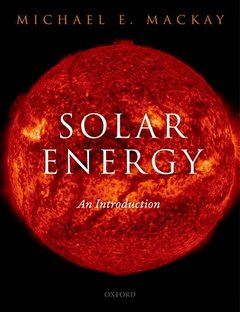Description
Solar Energy
An Introduction
Author: Mackay Michael E.
Language: English
Approximative price 49.02 €
In Print (Delivery period: 21 days).
Add to cart
Solar Energy
Publication date: 06-2015
256 p. · 19.4x24.7 cm · Paperback
Publication date: 06-2015
256 p. · 19.4x24.7 cm · Paperback
Approximative price 112.79 €
In Print (Delivery period: 21 days).
Add to cart
Solar Energy
Publication date: 06-2015
258 p. · 19.5x24.7 cm · Hardback
Publication date: 06-2015
258 p. · 19.5x24.7 cm · Hardback
Description
/li>Biography
/li>
Solar Energy presents an introduction to all aspects of solar energy, from photovoltaic devices to active and passive solar thermal energy conversion, giving both a detailed and broad perspective of the field. It is aimed at the beginner involved in solar energy or a related field, or for someone wanting to gain a broader perspective of solar energy technologies. A chapter considering solar radiation, basic principles applied to solar energy, semiconductor physics, and light absorption brings the reader on equal footing with the technology of either solar generated electrical current or useful heat. Details of how a solar cell works and then production of current from a photovoltaic device is discussed. Characterization of a solar cell is examined, allowing one the ability to interpret the current-voltage relation, followed by discussion of parameter extraction from this relation. This information can be used to understand what limits the performance of a given solar cell with the potential to optimize its performance. Applications of solar thermal energy are reviewed in detail from passive applications, for example the solar chimney, to active, such as the solar (power) tower, flat plate water heater, and solar thermal electricity generation. Consistency of analysis between the solar thermal applications is used enabling the reader to fully appreciate similarities and dissimilarities between these technologies. Ultimately, the scientist or engineer can understand existing systems, either photovoltaic or solar thermal devices, and design their own technology given the information in this book.
Michael E. Mackay received his undergraduate degree in chemical engineering with distinction from the University of Delaware, then worked for Proctor and Gamble prior to attending graduate school at the University of Illinois (Urbana) where he received M.S. and PhD degrees in chemical engineering. He subsequently became a postdoctoral fellow at the University of Melbourne (Australia), and has had positions at the University of Queensland (Australia), Stevens Institute of Technology, Michigan State University, and is presently the distinguished Professor of Materials Science and Engineering at the University of Delaware. He is a nationally and internationally known leader in nanotechnology specializing in how nanoparticles improve polymer performance and their use in making novel devices and materials. Recently, he has focused his research efforts to make polymer-based solar cells that that can be made on any surface.
© 2024 LAVOISIER S.A.S.




